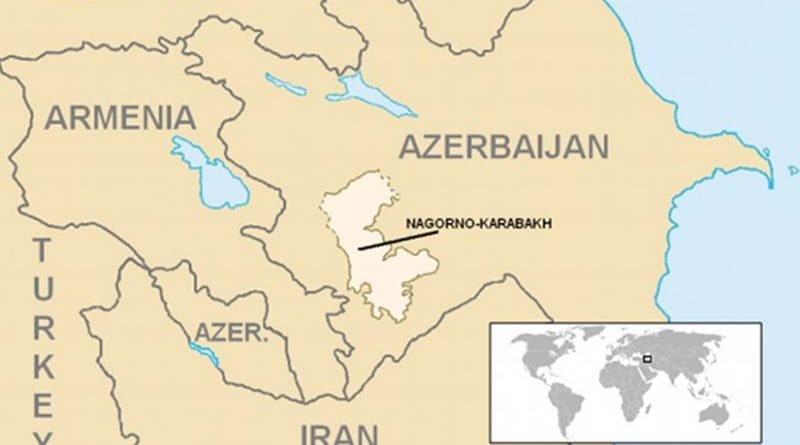Nagorno-Karabakh: At Least 32 Killed In Heavy Fighting
By RFE RL
(RFE/RL) — Intense fighting has been reported in the disputed region of Nagorno-Karabakh inside Azerbaijan, with heavy casualties reported on both sides and the OSCE expressing its “grave concern” at developments.
The Armenian military accused Azerbaijani forces of launching a major offensive, involving tanks, heavy artillery, and helicopter gunships.
The Azerbaijani military said its frontline forces had first come under “intensive fire” from mortars, grenade launchers, and artillery and that the Azerbaijani Army had to take “urgent measures” to respond.
The Azerbaijani Defense Ministry said that 12 soldiers had died in the fighting. It said one Mi-24 helicopter was shot down and that one tank had been destroyed in a mine explosion.
The ministry claimed the army had “liberated strategic heights and settlements” in the region.
“Six Armenian tanks were destroyed [and] more than 100 Armenian servicemen were killed and injured,” it said in a statement.
President Serzh Sarkisian said Azerbaijani troops had killed 18 ethnic Armenian soldiers.
“From our side, 18 soldiers were killed and some 35 others wounded,” Sarkisian said at a meeting of the National Security Council in Yerevan, according to his press office.
He did not specify if the soldiers belonged to Yerevan-backed separatist forces in Nagorno-Karabakh or Armenia’s armed forces.
Reports from the region said two civilians had also been killed, including a 12-year-old boy.
Nagorno-Karabakh lies inside Azerbaijan but is controlled by ethnic Armenians.
The Armenian Defense Ministry called it the most serious escalation of fighting in the conflict since a 1994 truce and called on the United States, Russia, and France — who lead international efforts to mediate the conflict — to urgently intervene.
Armenian Prime Minister Ovik Abrahamian convened an urgent meeting over the “unprecedented large-scale hostilities from the enemy,” the Armenian government said.
“Armenia is ready to take the necessary steps to stabilize the situation,” Abrahamian said.
Armenian President Serzh Sarkisian is expected to convene a Security Council meeting on the situation later on April 2.
In a statement, the co-chairs of the OSCE Minsk Group, which has been mediating the conflict, expressed “grave concern over the reported large-scale cease-fire violations that are taking place along the Line of Contact in the Nagorno-Karabakh conflict zone. We strongly condemn the use of force and regret the senseless loss of life, including civilians.
The statement — by ambassadors Igor Popov of Russia, James Warlick of the United States, and Pierre Andrieu of France — called upon the sides to stop shooting and take all necessary measures to stabilize the situation on the ground.
Warlick said on Twitter that the OSCE Minsk Group co-chairs will meet in Vienna on April 4 and convene the Minsk Group on April 5 to address the violence.
Russia’s President Vladimir Putin’s press secretary, Dmitry Peskov, said Putin is “deeply concerned about the reports on resumed military actions along the line of engagement in Nagorno-Karabakh.” He said Putin called on the parties to the conflict to implement an immediate cease-fire and to exercise restraint.
Russian Foreign Minister Sergei Lavrov later spoke separately by phone with the foreign ministers of Azerbaijan and Armenia to urge calm, the Russian Foreign Ministry said. Russia has sold arms to both sides in the conflict.
U.S. Secretary of State John Kerry condemned “in the strongest terms” the cease-fire violations while extending Washington’s condolences to all affected families.
“We urge the sides to show restraint, avoid further escalation, and strictly adhere to the ceasefire,” Kerry said in an April 2 statement.
He added that “the unstable situation on the ground demonstrates why the sides must enter into an immediate negotiation under the auspices of the OSCE Minsk Group Co-Chairs on a comprehensive settlement of the conflict.”
The U.S. top diplomat reiterated that there is no military solution to the conflict.
EU foreign policy chief Federica Mogherini called on the parties to stop the fighting immediately and observe the cease-fire.
“The sides must show restraint and avoid any further actions or statements that could result in escalation,” Mogherini said in a statement.
She said both sides should refrain from the use of force and resume efforts towards a peaceful resolution of the conflict.
Hikmat Hajiyev, a spokesman for Azerbaijan’s Foreign Ministry, called on the international community to condemn Armenia’s actions.
The conflict over Nagorno-Karabakh broke out in the dying years of the Soviet Union and killed about 30,000 people.
Years of diplomatic efforts, led by the OSCE, have been largely unsuccessful at resolving the simmering crisis between the two heavily armed neighbors.
The fresh outbreak of violence came as the presidents of both Azerbaijan and Armenia, Ilham Aliyev and Sarkisian, were winding up visits to the United States.
Just hours before the fighting broke out, Aliyev and Sarkisian met jointly with U.S. Vice President Joe Biden, who called on the South Caucasus leaders to peacefully settle the protracted dispute.
On March 30, U.S. Secretary of State John Kerry called for an “ultimate resolution” to the conflict during talks in Washington with Aliyev.
At his meeting with Kerry, Aliyev thanked the United States for trying to end the conflict but said it could only be resolved through a United Nations Security Council resolution calling for the “immediate and unconditional withdrawal of Armenian troops” from Azerbaijan.
Nagorno-Karabakh, populated mainly by ethnic Armenians, declared independence from Azerbaijan after a 1988-94 war that claimed an estimated 30,000 lives and displaced hundreds of thousands of people.
Internationally mediated negotiations with the involvement of the OSCE’s Minsk Group have failed to result in a resolution. The Minsk Group is co-chaired by France, Russia, and the United States.

